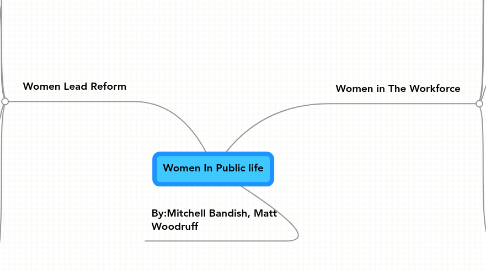
1. Women Lead Reform
1.1. Triangle Shirtwaist Factory Fire.
1.1.1. 146 people die in factory fire, most of them young women.
1.1.2. This event pushed for reform.
1.2. Women In Higher Education
1.2.1. Many of the active women in the 19th century, enrolled in colleges, in hope to further enrich their education.
1.2.2. Women were still expected to perform house hold jobs.
1.2.3. Late 19th century- Marriage is not only option for women.
1.2.4. Many college-educated women were single.
1.3. Women And Reform
1.3.1. Uneducated laborers pushed for reform.
1.3.2. 1896-NACW (National Association of Colored Women is founded. Managed nurseries, Kindegardens and reading-rooms.
1.3.3. Susan B. Anthony is a major player in the push for women's suffrage rights.
1.3.4. Women's suffrage faced constant oppositions and challenges.
1.4. A Three-Part Strategy
1.4.1. First women tried to convince state legislators to allow them the right to vote.
1.4.2. Second, they tried to pursue previous court cases to find that denying women the right to vote was "unconstitutional"
1.4.3. Third, women pushed for a national constitutional amendment.
2. By:Mitchell Bandish, Matt Woodruff
3. Women in The Workforce
3.1. Married Middle-Class women tool care of house and family.
3.2. Only Middle and upper-class women could do so.
3.3. Farm Women
3.3.1. Roles had not changed much since previous century.
3.3.2. Handled house hold chores, including raising livestock.
3.3.3. Plowed fields and harvested crops.
3.4. Women In Industry
3.4.1. Better paying opportunities in cities.
3.4.2. New options to find jobs.
3.4.3. One in five American Women held jobs. 1/4 of them in the Manufacturing Industry.
3.4.4. About half of those jobs were making garments.
3.4.5. Many of them were single.
3.4.6. Most jobs began to require a high school education. So, more women began to finish school.
3.4.7. New node
3.5. Domestic Workers
3.5.1. Many women that did not have a formal education, did domestic work.
3.5.1.1. cleaned for other house holds.
3.5.2. Almost 2 million African American workers fled into the workforce.
3.5.2.1. worked on farms.
3.5.2.2. were cooks, laundresses, and scrub women.
3.5.3. About 70% of women in 1870 were servants.
